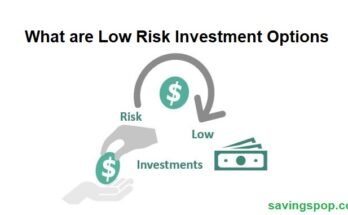“How to Diversify Investments for Retirement” offers essential strategies for building a robust and balanced retirement portfolio. Learn how to allocate assets across various investment types, such as stocks, bonds, real estate, & mutual funds, to minimize risk and maximize returns. This guide covers the importance of diversification, tips for choosing the right investments, and how to adjust your portfolio as you approach retirement. By spreading your investments, you can protect your savings from market volatility and ensure a more secure financial future. Ideal for both novice and experienced investors planning for retirement.
How to Diversify Investments For Retirement?
Planning for retirement can be both exciting and overwhelming. One of the key strategies for ensuring a financially secure retirement is diversification. Diversification involves spreading your investments across different types of assets to reduce risk. Instead of putting all your money into a single investment, diversification allows you to mitigate potential losses and stabilize returns over time. This strategy is vital because it helps protect your retirement savings from the volatility of financial markets.
What is Diversification?
Diversification is a risk management strategy that involves mixing a wide variety of investments within a portfolio. The goal is to smooth out potential losses by investing in assets that react differently to market conditions. For example, while stocks might be experiencing a downturn, bonds or real estate might perform well. This balance helps reduce the overall risk of your investment portfolio.
Why Diversify?
The primary reason for diversification is to manage risk. If you concentrate your investments in one area, such as technology stocks, you are exposed to the risks specific to that sector. A sudden downturn in the tech industry could significantly impact your savings. By diversifying, you spread your risk across various asset classes, industries, and geographic regions, which can help protect your investments from market fluctuations and economic downturns.
Understanding Retirement Goals
Before effectively diversifying your investments, you need to understand your retirement goals. This involves estimating your future needs and aligning your investment strategy with those needs.
Assessing Retirement Needs
To estimate your retirement needs, start by evaluating your expected expenses. Consider both essential costs, such as housing, healthcare, and daily living expenses, as well as discretionary spending, like travel and hobbies. Don’t forget to account for inflation, which erodes the purchasing power of your savings over time.
For example, if you expect to need $50,000 annually in retirement and plan to retire in 20 years, you need to account for inflation. Assuming an average inflation rate of 2%, the future value of $50,000 in today’s dollars would be approximately $73,000. Tools like retirement calculators can help you estimate how much you need to save monthly to reach your retirement goals.
Setting Investment Objectives
Once you have a clear understanding of your retirement needs, you can set specific investment objectives. Your investment strategy should reflect your financial goals, time horizon, and risk tolerance. If you are early in your career, you might prioritize growth investments, such as stocks, which can offer higher returns but come with more risk. As you get closer to retirement, you may shift towards more conservative investments, such as bonds, to preserve your capital and generate stable income.
Basic Principles of Investment Diversification
Understanding the principles of diversification helps you create a balanced investment portfolio. Let’s explore the key types of diversification and their benefits.
Types of Diversification
- Asset Class Diversification: This involves investing in different types of assets, such as stocks, bonds, real estate, and cash. Each asset class has its own risk and return profile. Stocks typically offer higher potential returns but come with higher risk, while bonds are generally more stable but offer lower returns. By investing in a mix of asset classes, you can reduce the impact of poor performance in any single asset class on your overall portfolio.
- Geographical Diversification: Investing in different geographic regions helps protect your portfolio from local economic downturns. For example, if the U.S. economy is experiencing a recession, international markets might be performing better. By diversifying across regions, you reduce the risk associated with any single country’s economic conditions.
- Sector Diversification: Different sectors of the economy perform differently at various times. By investing in a range of sectors, such as technology, healthcare, finance, and consumer goods, you can mitigate the risk associated with a downturn in any single sector. Sector diversification ensures that your portfolio is not overly dependent on the performance of one industry.
Benefits of Diversification
The primary benefit of diversification is risk reduction. By spreading your investments across various asset classes, geographic regions, and sectors, you reduce the likelihood of significant losses. Diversification helps stabilize returns and can lead to more consistent performance over time. It also provides opportunities for growth in different market conditions, helping you achieve your retirement goals more effectively.
Asset Allocation Strategies
Asset allocation is a crucial aspect of diversification. It involves distributing your investments among different asset classes based on your risk tolerance, investment goals, and time horizon. Let’s explore different asset classes and strategies for effective allocation.
Stocks
Stocks represent ownership in a company and offer the potential for high returns. However, they also come with higher risk. When diversifying with stocks, consider:
- Blue-Chip Stocks: These are shares in large, well-established companies with a history of stable earnings and reliable performance. They are generally less volatile than smaller companies and provide a steady income through dividends.
- Growth Stocks: These stocks belong to companies that are expected to grow at an above-average rate compared to other companies. They offer the potential for significant capital appreciation but come with higher risk.
- Dividend-Paying Stocks: Stocks that pay dividends provide a steady income stream in addition to potential capital gains. They can be particularly useful in retirement for generating regular income.
Bonds
Bonds are fixed-income securities that pay interest over a specified period. They are generally considered less risky than stocks and provide a steady income. Types of bonds include:
- Government Bonds: Issued by national governments, these bonds are considered very safe and offer lower yields compared to other bonds. They are backed by the government’s creditworthiness.
- Corporate Bonds: Issued by companies, these bonds typically offer higher yields than government bonds but come with higher risk. The risk level depends on the issuing company’s credit rating.
- Municipal Bonds: Issued by state or local governments, municipal bonds often offer tax benefits. They can be a good choice for investors seeking tax-free income.
Real Estate
Investing in real estate can provide both income and potential for appreciation. There are several ways to invest in real estate:
- Direct Ownership: Purchasing property to rent out or sell can provide a steady income and potential capital gains. However, direct ownership requires significant capital and active management.
- REITs (Real Estate Investment Trusts): REITs are companies that own, operate or finance income-producing real estate. They offer a way to invest in real estate without owning physical property and provide liquidity as they are traded on stock exchanges.
- Real Estate Crowdfunding: This allows you to invest in real estate projects with other investors through online platforms. It provides access to real estate investments with lower capital requirements.
Cash and Cash Equivalents
Cash and cash equivalents provide liquidity and stability. They include:
- Savings Accounts: These are safe and easily accessible but offer lower returns compared to other investments.
- Money Market Funds: These are short-term investments that offer higher returns than savings accounts and provide liquidity.
Advanced Diversification Techniques
To enhance your diversification strategy, consider advanced techniques that offer broader exposure to various assets.
Mutual Funds and ETFs
- Mutual Funds: These are investment vehicles that pool money from multiple investors to buy a diversified portfolio of stocks, bonds, or other assets. They are managed by professional fund managers who make investment decisions on behalf of investors. Mutual funds offer diversification and are suitable for investors looking for professional management.
- ETFs (Exchange-Traded Funds): ETFs are similar to mutual funds but are traded on stock exchanges. They offer diversification and typically have lower fees than mutual funds. ETFs track specific indexes, sectors, or asset classes, providing broad market exposure.
Index Funds
Index funds are designed to track a specific market index, such as the S&P 500. They offer broad market exposure and typically have lower fees than actively managed funds. Index funds are a cost-effective way to achieve diversification and align with long-term investment goals.
Alternative Investments
- Commodities: Investing in physical goods like gold, silver, or oil can hedge against inflation and provide diversification. Commodities can be volatile, so they should be a small portion of your portfolio.
- Private Equity: This involves investing in private companies that are not publicly traded. Private equity investments offer high potential returns but come with higher risk and lower liquidity.
- Hedge Funds: Hedge funds use various strategies to achieve high returns. They can invest in stocks, bonds, derivatives, and other assets. Hedge funds are often suitable for high-net-worth individuals due to their complexity and higher fees.
Risk Management and Tolerance
Understanding and managing risk is a crucial aspect of diversification. Your risk tolerance determines how much risk you can handle and should guide your investment decisions.
Assessing Risk Tolerance
Risk tolerance is influenced by several factors:
- Time Horizon: The length of time you plan to invest before needing the money affects your risk tolerance. Longer time horizons allow for higher risk as you have more time to recover from market fluctuations.
- Financial Situation: Your current financial health, income stability, and existing assets play a role in determining your risk tolerance. A more stable financial situation allows for higher risk tolerance.
- Investment Goals: Your retirement goals, such as your desired income and lifestyle, impact your risk tolerance. Higher goals might require more aggressive investments, while conservative goals necessitate lower risk.
Balancing Risk and Return
Balancing risk and return involves creating a portfolio that aligns with your risk tolerance and investment goals. This typically means combining higher-risk investments, like stocks, with lower-risk investments, like bonds. The goal is to achieve a mix that provides potential growth while managing risk.
Rebalancing
Rebalancing is the process of adjusting your portfolio to maintain your desired asset allocation. Over time, market fluctuations can cause your portfolio to deviate from its intended allocation. Regular rebalancing ensures that your portfolio remains aligned with your risk tolerance and investment goals.
Retirement Accounts and Investment Platforms
Utilizing various retirement accounts and investment platforms can optimize your diversification strategy and provide tax advantages.
401(k) and 403(b) Plans
- 401(k) Plans: These employer-sponsored retirement plans allow you to contribute pre-tax income, reducing your taxable income. Many employers offer matching contributions, which are essentially free money for your retirement.
- 403(b) Plans: Similar to 401(k) plans, 403(b) plans are available to employees of public schools and certain non-profit organizations. They also offer tax-deferred growth and, in some cases, employer matching.
IRAs (Individual Retirement Accounts)
- Traditional IRA: Contributions are tax-deductible, and the investments grow tax-deferred until you withdraw the funds in retirement. Required minimum distributions (RMDs) begin at age 73.
- Roth IRA: Contributions are made with after-tax dollars, but qualified withdrawals are tax-free. Roth IRAs have no RMDs, making them an attractive option for those who expect to be in a higher tax bracket in retirement.
SEP IRA and SIMPLE IRA
- SEP IRA: Designed for self-employed individuals and small business owners, SEP IRAs allow higher contribution limits compared to traditional IRAs and offer tax-deferred growth.
- SIMPLE IRA: Aimed at small businesses, SIMPLE IRAs offer a straightforward way for employees and employers to contribute to retirement savings with lower administrative costs.
Investment Platforms
- Brokerage Accounts: These accounts allow you to buy and sell a wide range of investments, including stocks, bonds, and mutual funds. Brokerage accounts offer flexibility but lack the tax advantages of retirement accounts.
- Robo-Advisors: Automated investment platforms use algorithms to create and manage a diversified portfolio based on your risk tolerance and goals. They offer low fees and convenience for investors who prefer a hands-off approach.
Tax Considerations
Tax efficiency is an important aspect of investment diversification. Different investments and accounts have varying tax implications, which can impact your overall returns.
Tax-Advantaged Accounts
- 401(k) and IRA Contributions: Contributions to traditional retirement accounts are typically tax-deductible, reducing your current taxable income. However, withdrawals are taxed as ordinary income during retirement.
- Roth Accounts: Roth IRA contributions are made with after-tax dollars, but qualified withdrawals are tax-free. This can be advantageous if you expect to be in a higher tax bracket in retirement.
Taxable Accounts
- Capital Gains Tax: Investments held in taxable accounts are subject to capital gains tax on profits realized from sales. Long-term capital gains (on investments held for over a year) are taxed at a lower rate compared to short-term gains.
- Dividend Tax: Dividends received from investments in taxable accounts are subject to income tax. Qualified dividends are taxed at a lower rate than ordinary income.
Periodic Review and Adjustments
Regularly reviewing and adjusting your investment portfolio is crucial for maintaining an effective diversification strategy.
Monitoring Performance
Track the performance of your investments and compare them to your goals and benchmarks. Regular monitoring helps identify any underperforming assets and allows you to make informed decisions about adjustments.
Rebalancing
Rebalancing involves adjusting your portfolio to maintain your desired asset allocation. For example, if stocks have performed well and now make up a larger portion of your portfolio, you might sell some stocks and invest in other asset classes to restore balance.
Adapting to Life Changes
Life events, such as marriage, the birth of a child, or changes in income, can impact your investment strategy. Adjust your portfolio as needed to reflect changes in your financial situation, goals, and risk tolerance.
Seeking Professional Advice
If managing investments and diversification feels overwhelming, consider seeking professional advice.
Financial Advisors
Financial advisors can provide personalized investment advice and help you create a diversified portfolio that aligns with your goals and risk tolerance. They offer expertise in asset allocation, tax planning, and retirement planning.
Robo-Advisors
Robo-advisors offer automated investment management based on algorithms and pre-set criteria. They are a cost-effective option for investors seeking professional management without the high fees associated with human advisors.
Investment Services
Many investment services offer tools and resources to help you manage your portfolio and make informed decisions. These services can provide market insights, portfolio analysis, and educational materials to enhance your investment knowledge.
Case Studies and Examples
Real-life examples can illustrate the benefits of diversification and provide practical insights.
Case Study 1: The Balanced Retiree
John, a 60-year-old approaching retirement, had most of his savings invested in technology stocks. When the tech sector experienced a downturn, his portfolio suffered significant losses. By diversifying his investments into bonds, real estate, and international stocks, John was able to stabilize his portfolio and reduce risk, providing a more secure foundation for his retirement.
Case Study 2: The Young Investor
Sarah, a 30-year-old with a long time horizon, invested heavily in high-growth stocks. As she approached her 40s, she began to shift her investments toward a mix of stocks, bonds, and real estate to reduce risk and prepare for retirement. Her diversified portfolio provided a balance of growth and stability, helping her achieve her retirement goals.
Conclusion
Learning how to diversify investments for retirement is essential for mitigating risks and optimizing returns. By spreading investments across various asset classes such as stocks, bonds, real estate, and mutual funds, individuals can protect their portfolios from market volatility. Regularly reviewing and adjusting allocations based on market conditions and personal financial goals ensures long-term stability and growth. Engaging with financial advisors and staying informed about market trends can further enhance investment strategies. Ultimately, a well-diversified portfolio can provide a more secure and comfortable retirement, safeguarding financial well-being for the future.
Recap of Key Points
- Diversification helps protect your portfolio from significant losses by spreading risk across different investments.
- Asset allocation strategies, including investments in stocks, bonds, real estate, and cash, play a vital role in diversification.
- Understanding and adjusting your risk tolerance is essential for maintaining a balanced portfolio.
- Utilizing various retirement accounts and investment platforms can optimize your diversification strategy and provide tax advantages.
Action Plan
- Assess Your Retirement Goals and Needs: Begin by estimating your future retirement expenses and aligning your investment strategy with those needs.
- Create a Diversified Investment Portfolio: Based on your risk tolerance and time horizon, develop a portfolio that includes a mix of asset classes, sectors, and geographic regions.
- Regularly Review and Rebalance Your Portfolio: Monitor your investments, track performance, and make adjustments as needed to maintain your desired asset allocation.
- Use Tools and Resources: Take advantage of retirement calculators, financial advisors, and investment platforms to stay informed and make informed decisions.
Final Thoughts
Diversifying your investments for retirement is not a one-time task but an ongoing process. By staying informed and proactive, you can build a robust portfolio that helps you achieve a secure and comfortable retirement. Remember, effective diversification requires a thoughtful approach and regular adjustments based on your financial situation and goals.




